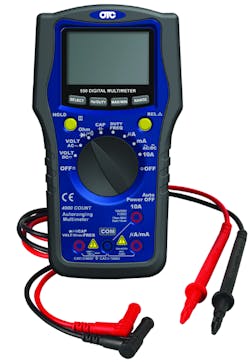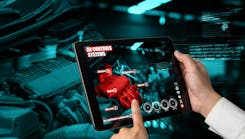Get smart on battery health
In traditional internal combustion engine (ICE) vehicles, the engine is the heart of the car. In hybrid, EV, BEV and PHEV, the battery is the heart of the car. The primary focal point of a vehicle has shifted with the introduction of EVs to the market – and how we define the health of a car battery has changed, too.
We define the health of a car battery by viewing its overall power and performance. As the electrical pulse of the vehicle, it's important to be in tune with battery health and stay updated with the evolving industry standards for maintenance. The industry is currently experiencing the rapid digitization of auto repair shops, using specialized software and tools to accurately diagnose all issues in a vehicle. With the industry moving in this direction, there’s a growing need for smart tools in the shop to optimize data access, time, cost-effectiveness, and communication, as vehicles become increasingly connected.
From smart multimeters to smart chargers, shop owners need to familiarize themselves with these “smart” tools to keep up with the battery maintenance needs of “smarter” vehicles – especially with the rapid growth of the electric vehicle (EV) market. According to the financial data firm Experian, EV registrations shot up by 60 percent in the first quarter of 2022, accounting for a record 4.6 percent of all new vehicle registrations in the U.S. With this impending influx of EVs hitting the market, technicians now more than ever need to be familiar with smart tools. The importance of battery diagnostics will also continue to grow, as the battery is the core component of an EV and accounts for 30 to 40 percent of the EV cost. Although not all technicians may perform maintenance on EV batteries just yet, there are steps they can take to prepare for the future of vehicle servicing.
Diagnosing battery health
Technicians will be most familiar with checking the battery health of an ICE vehicle. This checkup includes reviewing the cold cranking amps and reserve capacity using a digital multimeter when connected to the battery terminals. ICE vehicles are now built with battery health updates on the dash to keep the driver informed when the car needs maintenance.
When it comes to EVs, we refer to checking the battery’s state of health (SOH). An EV battery’s SOH measures in kilowatt-hours, which is the same unit used to measure the energy found in a home or apartment. The powerful lithium-ion battery in an EV holds several cell pockets housed in the vehicle's undercarriage. As a result, maintenance of an EV battery tends to be more complex with several moving parts mixed in – with the added danger of higher voltage. Luckily, EVs paved the way for dashboard testing, which will inform the driver of battery malfunctions in real-time.
Diagnosing a car battery malfunction in a timely manner will help avoid major issues for the car overall. For a typical vehicle, it is recommended to inspect the battery at least twice per year or every 6,000 miles. This is where EV battery maintenance will vary. Most EV batteries will last somewhere between 10 to 20 years before they need to be replaced. Lithium-ion batteries are built to be longer-lasting and often come with the option for lengthy warranties. Despite their durability, EV batteries should still be checked at least once every year with traditional routine maintenance.
What can impact a car’s battery health?
Before diagnosing battery health, it’s important to understand how these varying batteries are designed and what external and internal impacts may affect their lifespan. Using battery testers, we can analyze the battery’s voltage, amperage, and status to determine the battery’s ability to perform basic tasks like starting in cold temperatures or maintaining a full charge.
Usually technicians will encounter conventional lead-acid batteries and, on occasion, the more advanced AGM battery. Factors like extreme temperatures, dirt and corrosion, staying up to date on maintenance, loose hardware, and the use of exterior and interior lights will impact the car battery’s ability to perform over time.
Now, with more EVs hitting the market, technicians will continue to encounter lithium-ion batteries in their shops. Much like traditional batteries, the external and internal impacts on a lithium-ion battery are the same. Extreme temperatures will impact an EV’s battery lifespan. For this reason, EVs have a built-in thermal battery management system which protects the battery from overheating. Excessive speeding can also greatly impact the battery health of an EV and the battery's allotted cooling time after driving – we recommend about a half-hour after completing a trip. Most importantly, the ideal “state of charge” for EVs is from 20 to 80 percent and only 100 percent for long-distance driving. Keeping the charge to 100 percent or close to zero percent will degrade the battery faster and cause it to lose capacity.
Smart tools for smart diagnostics
Like the smart home system you may find in a modern home, smart shop tools are making it easier for technicians to communicate with their peers and keep track of workflow. Smart tools on the market range from a variety of products such as smart multimeters, smart chargers, to overall smart instruments which perform all functions of battery maintenance. Although designed to be intuitive, technicians need proper training to become familiar with smart tools as EVs rely on these tools.
Smart chargers can provide many automated options that are much more sophisticated than traditional tools. They can offer multiple charging modes from normal to fast and are programmed to deliver different outputs for different conditions of the battery.
Similarly, a smart multimeter is an advanced tool that can support testing of a vehicle’s battery and accurately produce data on the battery power, current, and voltage. These tools usually come equipped with applications as well, allowing multiple technicians in one shop to get updated on the status of a battery via their smartphone to synchronize tasks better.
In the future, we can imagine it being standard practice for shops to house smart EV charging stations that can allow for the efficient charging of EVs staying in the shop for extended periods of time. Shops will soon become familiar with the latest software updates for various EVs to maintain the car and its battery properly.
It starts with training
For technician training beyond smart tool usage, understanding system operations and safety precautions for EVs will be more critical than ever before. EVs can produce five or more different circuit voltages, ranging from 12V to 650V, and feature dozens of interconnected modules. The complexity of the EV system has brought to light the need for proper technician training and safety precautions, as well as emphasizing the need for advanced tools. The best thing shop owners can do now to prepare their teams for the future of vehicle servicing is to invest in training to empower technicians as the industry makes the shift.



